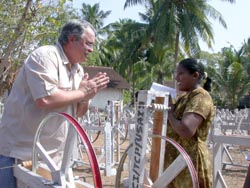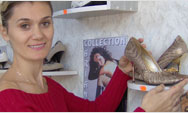You are here » Home » Telling Our Story
Success Story
Replacing equipment
lets hundreds of women
get back to work
Restoring Textile Workers’ Livelihoods

| |
Photo: USAID/Zack Taylor
|
|
USAID’s Jeff Allen presents Piyawathi
De Silva new coir spinning equipment.
“This equipment will give
us a new start we couldn’t
have made otherwise
without money,” said
Piyawathi.
|
In rural Madampagama on Sri Lanka’s southern coast, December
26 began for Piyawathi De Silva and her two daughters with
their usual work of spinning coconut husks (known as coir) into
rope. Before the morning was over, the sea had swept away all
of Piyawathi’s equipment—and her means to help her
fisherman husband support the family. Piyawathi is one of
about 3,000 coir spinners in Sri Lanka to lose their livelihoods
in the tsunami. Yet she considers herself lucky:
more than 75 members of the community of coir workers
along the south coast were killed.
Just five weeks later, Piyawathi and other spinners were
back at work, thanks to help from USAID and its partners.
Double-wheeled spinning units used by Piyawathi and
other workers are fabricated by local blacksmiths and carpenters
from wood and bicycle rims and are worth $20
each. In eight hours, three people can produce 30 pounds
of coir rope for a profit of $3. Most spinners are married
women, and the process is a family affair: often three generations
of women can be found working together on the wheels.
USAID funded the purchase and distribution of 500 spinning
sets for the neediest workers and collaborated with partners to
supply 100 more units, as well as bales of raw material needed
to produce coir rope.
“This equipment will give us a new start we couldn’t have made
otherwise without money,” said Piyawathi after receiving her
supplies on February 9. “From the profits we earn from this
batch, we will buy more raw materials. Eventually we can begin
to replace some of the things we lost.”
Livelihood-restoring programs such as this are a key facet of
USAID’s strategy to help Sri Lanka recover from the tsunami’s
devastation. Immediately after the disaster, USAID provided
emergency food, shelter, water, sanitation and medical supplies.
But now it is helping Sri Lanka plan its long-term recovery,
by establishing cash-for-work programs to clean up debris
and repair damaged property. Small loans are helping people
repair boats, reopen shops and start new businesses. USAID is
also working with international and local organizations to provide
psychological and social support to help individuals, families
and communities cope with the trauma they experienced.
Print-friendly version of this page (74kb - PDF)
Click here for high-res photo
Back to Top ^ | 

